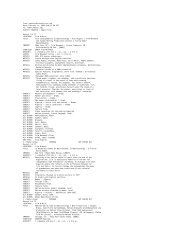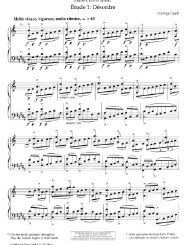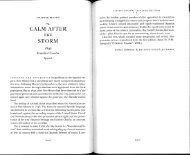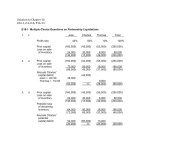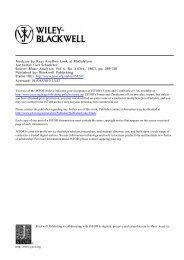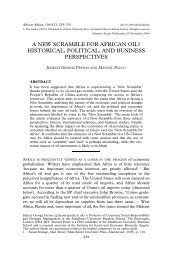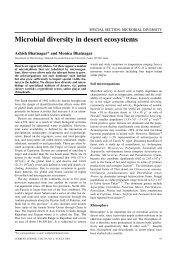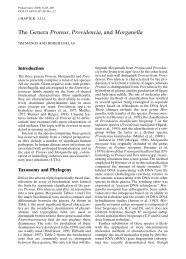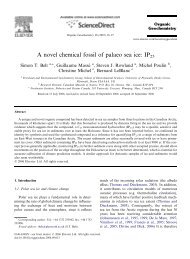The Genus Serratia
The Genus Serratia
The Genus Serratia
Create successful ePaper yourself
Turn your PDF publications into a flip-book with our unique Google optimized e-Paper software.
228 F. Grimont and P.A.D. Grimont CHAPTER 3.3.11<br />
Enzymes<br />
<strong>The</strong> most probable potential use of chitinase is<br />
in the treatment of the chitin-containing wastes<br />
produced by the seafood packing industry, biocontrol<br />
agents against plant pathogenic fungi,<br />
production of adhesives and wound dressings,<br />
heavy metal recovery from waters, delayedrelease<br />
agrochemicals or drugs, and dialysis<br />
membranes (Joshi et al., 1989). S. marcescens<br />
produces five proteins (molecular masses of 57,<br />
52, 48, 36, and 21 kDa) with chitinolytic activity<br />
(Fuchs et al., 1986) whereas S. liquefaciens produces<br />
three proteins (molecular masses of 56, 51,<br />
and 36 kDa) with such activity (Joshi et al., 1989).<br />
<strong>The</strong> sequences of two S. marcescens chitinase<br />
genes, chiA encoding the 57 kD enzyme and<br />
chiB encoding the 52 kD enzyme, have been<br />
published (Jones et al., 1986; Harpster and<br />
Dunsmuir, 1989).<br />
Biotechnology<br />
<strong>Serratia</strong> strains have been used in whole-cell<br />
bioconversion processes. Resting-cell suspensions<br />
of S. marcescens are able to convert<br />
vanillin to vanillic acid. At high substrate concentration<br />
(0.3%), 75% vanillin is converted<br />
(Perestello et al., 1989). 2,5-Diketogluconic acid,<br />
a key intermediate in the synthesis of ascorbic<br />
acid, can be produced from glucose at 20°C by<br />
S. marcescens (without requirement for a cofactor)<br />
and by S. liquefaciens and S. grimesii when<br />
supplied with the cofactor, pyrroloquinoline<br />
quinone (Bouvet et al., 1989).<br />
Some genetic tools are available to construct<br />
S. marcescens strains of biotechnological interest.<br />
<strong>The</strong>se tools include general transduction (Matsumoto<br />
et al., 1973), transformation (Reid et al.,<br />
1982), and use of nuclease-deficient, antibioticsensitive,<br />
and restrictionless mutants (reference<br />
is not an exact match Takagi and Kisumi, 1985).<br />
Recombinant strains obtained were histidaseless<br />
regulatory mutants producing L-histidine<br />
(Kisumi et al., 1977), L-arginine-producing<br />
mutants (Kisumi et al., 1978), an isoleucine-producing<br />
strain (Komatsubara et al., 1980), and a<br />
threonine-hyperproducing strain (Komatsubara<br />
et al., 1983).<br />
Isolation<br />
Underlying Principles<br />
Pigmented species and biotypes of <strong>Serratia</strong> often<br />
exhibit pink or red colonies on nutrient agar.<br />
Use of low-phosphate agar without glucose,<br />
such as peptone-glycerol agar (Difco peptone,<br />
5 g; glycerol, 10 ml; Difco agar, 20 g; distilled<br />
water, 1 liter), is best in order to demonstrate<br />
pigmentation (Williams and Hearn, 1967).<br />
Although the genus <strong>Serratia</strong> includes all the redpigmented<br />
enterobacteria, identification of a<br />
pink or red colony should be confirmed by biochemical<br />
tests because a few nonenterobacteria<br />
may also produce prodigiosin (see “Introduction”).<br />
On nutrient agar, nonpigmented species<br />
or biotypes of <strong>Serratia</strong> give opaque-whitish,<br />
mucoid, or transparent smooth colonies. None<br />
of these traits is specific for the isolation of<br />
<strong>Serratia</strong> from a mixture of enteric bacteria.<br />
Colonies of S. odorifera and S. ficaria and<br />
occasionally S. rubidaea give off a specific,<br />
potato-like odor. Detection of this odor may<br />
suggest the presence of at least one colony of<br />
that species on the plate.<br />
<strong>The</strong> salt tolerance and relatively low minimal<br />
growth temperature of all <strong>Serratia</strong> species may<br />
help devise a means of enriching them. A nutrient<br />
broth containing 4% NaCl, incubated at 15–<br />
20°C, will allow multiplication of <strong>Serratia</strong> but not<br />
of Enterobacter cloacae or Aeromonas hydrophila<br />
(P. A. D. Grimont, unpublished observations).<br />
This procedure has been used by us, but<br />
no systematic study of its effectiveness has been<br />
conducted.<br />
Strains of the genus <strong>Serratia</strong> do not normally<br />
require addition of growth factors to a minimal<br />
medium. Thus, an enrichment medium for <strong>Serratia</strong><br />
can be a minimal medium with a carbon<br />
source that is commonly used by <strong>Serratia</strong> spp. but<br />
not by non-<strong>Serratia</strong> spp.<br />
Production of extracellular gelatinase, lecithinase,<br />
and DNase are essential characteristics of<br />
the genus <strong>Serratia</strong> (Ewing, 1986; Grimont et al.,<br />
1977b), S. fonticola excepted. Agar media that<br />
show the presence of one or a combination of<br />
extracellular enzymes can be used to differentiate<br />
<strong>Serratia</strong> colonies.<br />
Finally, <strong>Serratia</strong> spp. are resistant to several<br />
compounds, including colistimethate, cephalothin<br />
(Greenup and Blazevic, 1971), and thallium<br />
salts (Starr et al., 1976), and one of these<br />
compounds can be used to make enrichment or<br />
differential media selective for <strong>Serratia</strong>. However,<br />
some S. plymuthica or S. rubidaea strains<br />
may be more susceptible to colistimethate, cephalothin,<br />
or ampicillin than is S. marcescens.<br />
No medium has yet been devised to selectively<br />
isolate one particular <strong>Serratia</strong> species (other than<br />
S. marcescens), although specific carbon sources<br />
or conditions are listed in taxonomic papers<br />
(Grimont et al., 1977b). Occasionally, a selective<br />
medium may be devised according to a specific<br />
pattern of antibiotic resistance displayed by a<br />
nosocomial strain of S. marcescens (Denis and<br />
Blanchard, 1975), but such media cannot be of<br />
general utility.



